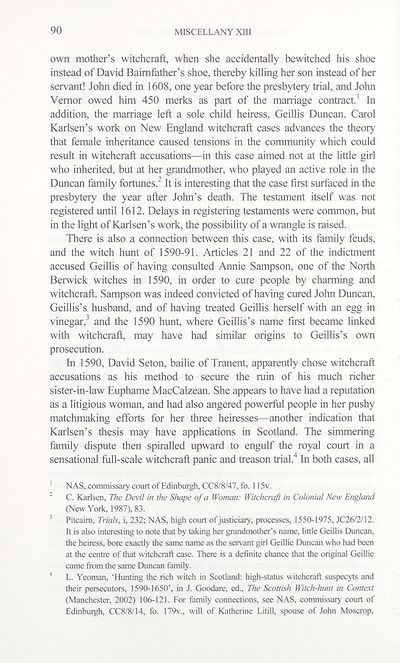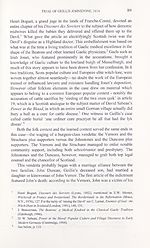Series 5 > Miscellany [of the Scottish History Society] XIII
(105) Page 90
Download files
Complete book:
Individual page:
Thumbnail gallery: Grid view | List view

90
MISCELLANY XIII
own mother’s witchcraft, when she accidentally bewitched his shoe
instead of David Baimfather’s shoe, thereby killing her son instead of her
servant! John died in 1608, one year before the presbytery trial, and John
Vemor owed him 450 merks as part of the marriage contract.1 In
addition, the marriage left a sole child heiress, Geillis Duncan. Carol
Karlsen’s work on New England witchcraft cases advances the theory
that female inheritance caused tensions in the community which could
result in witchcraft accusations—in this case aimed not at the little girl
who inherited, but at her grandmother, who played an active role in the
Duncan family fortunes.2 It is interesting that the case first surfaced in the
presbytery the year after John’s death. The testament itself was not
registered until 1612. Delays in registering testaments were common, but
in the light of Karlsen’s work, the possibility of a wrangle is raised.
There is also a connection between this case, with its family feuds,
and the witch hunt of 1590-91. Articles 21 and 22 of the indictment
accused Geillis of having consulted Annie Sampson, one of the North
Berwick witches in 1590, in order to cure people by charming and
witchcraft. Sampson was indeed convicted of having cured John Duncan,
Geillis’s husband, and of having treated Geillis herself with an egg in
vinegar,3 and the 1590 hunt, where Geillis’s name first became linked
with witchcraft, may have had similar origins to Geillis’s own
prosecution.
In 1590, David Seton, bailie of Tranent, apparently chose witchcraft
accusations as his method to secure the ruin of his much richer
sister-in-law Euphame MacCalzean. She appears to have had a reputation
as a litigious woman, and had also angered powerful people in her pushy
matchmaking efforts for her three heiresses—another indication that
Karlsen’s thesis may have applications in Scotland. The simmering
family dispute then spiralled upward to engulf the royal court in a
sensational full-scale witchcraft panic and treason trial.4 In both cases, all
1 NAS, commissary court of Edinburgh, CC8/8/47, fo. 115v.
2 C. Karlsen, The Devil in the Shape of a Woman: Witchcraft in Colonial New England
(New York, 1987), 83.
3 Pitcairn, Trials, i, 232; NAS, high court of justiciary, processes, 1550-1975, JC26/2/12.
It is also interesting to note that by taking her grandmother’s name, little Geillis Duncan,
the heiress, bore exactly the same name as the servant girl Geillie Duncan who had been
at the centre of that witchcraft case. There is a definite chance that the original Geillie
came from the same Duncan family.
4 L. Yeoman, ‘Hunting the rich witch in Scotland: high-status witchcraft suspecyts and
their persecutors, 1590-1650’, in J. Goodare, ed., The Scottish Witch-hunt in Context
(Manchester, 2002) 106-121. For family connections, see NAS, commissary court of
Edinburgh, CC8/8/14, fo. 179v., will of Katherine Litill, spouse of John Moscrop,
MISCELLANY XIII
own mother’s witchcraft, when she accidentally bewitched his shoe
instead of David Baimfather’s shoe, thereby killing her son instead of her
servant! John died in 1608, one year before the presbytery trial, and John
Vemor owed him 450 merks as part of the marriage contract.1 In
addition, the marriage left a sole child heiress, Geillis Duncan. Carol
Karlsen’s work on New England witchcraft cases advances the theory
that female inheritance caused tensions in the community which could
result in witchcraft accusations—in this case aimed not at the little girl
who inherited, but at her grandmother, who played an active role in the
Duncan family fortunes.2 It is interesting that the case first surfaced in the
presbytery the year after John’s death. The testament itself was not
registered until 1612. Delays in registering testaments were common, but
in the light of Karlsen’s work, the possibility of a wrangle is raised.
There is also a connection between this case, with its family feuds,
and the witch hunt of 1590-91. Articles 21 and 22 of the indictment
accused Geillis of having consulted Annie Sampson, one of the North
Berwick witches in 1590, in order to cure people by charming and
witchcraft. Sampson was indeed convicted of having cured John Duncan,
Geillis’s husband, and of having treated Geillis herself with an egg in
vinegar,3 and the 1590 hunt, where Geillis’s name first became linked
with witchcraft, may have had similar origins to Geillis’s own
prosecution.
In 1590, David Seton, bailie of Tranent, apparently chose witchcraft
accusations as his method to secure the ruin of his much richer
sister-in-law Euphame MacCalzean. She appears to have had a reputation
as a litigious woman, and had also angered powerful people in her pushy
matchmaking efforts for her three heiresses—another indication that
Karlsen’s thesis may have applications in Scotland. The simmering
family dispute then spiralled upward to engulf the royal court in a
sensational full-scale witchcraft panic and treason trial.4 In both cases, all
1 NAS, commissary court of Edinburgh, CC8/8/47, fo. 115v.
2 C. Karlsen, The Devil in the Shape of a Woman: Witchcraft in Colonial New England
(New York, 1987), 83.
3 Pitcairn, Trials, i, 232; NAS, high court of justiciary, processes, 1550-1975, JC26/2/12.
It is also interesting to note that by taking her grandmother’s name, little Geillis Duncan,
the heiress, bore exactly the same name as the servant girl Geillie Duncan who had been
at the centre of that witchcraft case. There is a definite chance that the original Geillie
came from the same Duncan family.
4 L. Yeoman, ‘Hunting the rich witch in Scotland: high-status witchcraft suspecyts and
their persecutors, 1590-1650’, in J. Goodare, ed., The Scottish Witch-hunt in Context
(Manchester, 2002) 106-121. For family connections, see NAS, commissary court of
Edinburgh, CC8/8/14, fo. 179v., will of Katherine Litill, spouse of John Moscrop,
Set display mode to:
![]() Universal Viewer |
Universal Viewer | ![]() Mirador |
Large image | Transcription
Mirador |
Large image | Transcription
Images and transcriptions on this page, including medium image downloads, may be used under the Creative Commons Attribution 4.0 International Licence unless otherwise stated. ![]()
| Scottish History Society volumes > Series 5 > Miscellany [of the Scottish History Society] XIII > (105) Page 90 |
|---|
| Permanent URL | https://digital.nls.uk/127314789 |
|---|
| Description | Over 180 volumes, published by the Scottish History Society, containing original sources on Scotland's history and people. With a wide range of subjects, the books collectively cover all periods from the 12th to 20th centuries, and reflect changing trends in Scottish history. Sources are accompanied by scholarly interpretation, references and bibliographies. Volumes are usually published annually, and more digitised volumes will be added as they become available. |
|---|


